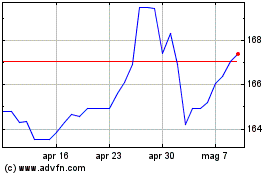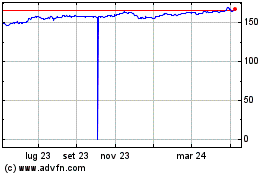Euro Higher After Eurozone PMI Data
01 Settembre 2021 - 9:55AM
RTTF2
The euro was higher against its most major counterparts in the
European session on Wednesday, after a data showed that the euro
area manufacturing logged another strong growth in August but the
pace of momentum waned as supply issues weighed on production.
Final data from IHS Markit showed that the manufacturing
Purchasing Managers' Index fell to a six-month low of 61.4 in
August from 62.8 in July. The flash reading was 61.5.
This marked a second successive month in which growth has slowed
in the sector since June's survey record expansion.
Data from Eurostat showed that the euro area unemployment rate
declined in July as economies reopened from the second wave.
The unemployment rate fell to 7.6 percent in July, as expected,
from 7.8 percent in June. In the same period last year, the jobless
rate was 8.4 percent.
European stocks rose as weak factory activity data from China
raised hopes for more stimulus measures.
The euro rose to 1.1824 against the greenback, from a 2-day low
of 1.1794 seen at 2:15 am ET. The euro may find resistance around
the 1.20 level.
The euro climbed to 130.44 against the yen, its highest level
since July 30. If the euro rises further, 132 is likely seen as its
next resistance level.
The euro rebounded to 0.8595 against the pound, after falling to
0.8574 at 2:30 am ET. Next immediate resistance for the euro is
seen around the 0.88 level.
The euro held steady against the franc, after touching 1.0846,
which was its highest level since July 21. The pair had ended
yesterday's trading at 1.0807.
Looking ahead, U.S. ADP private payrolls data for August is
scheduled for release at 8:15 am ET.
At 10:00 am ET, U.S. ISM manufacturing PMI for August and
construction spending for July will be released.
Grafico Cross Euro vs Yen (FX:EURJPY)
Da Mar 2024 a Apr 2024

Grafico Cross Euro vs Yen (FX:EURJPY)
Da Apr 2023 a Apr 2024
